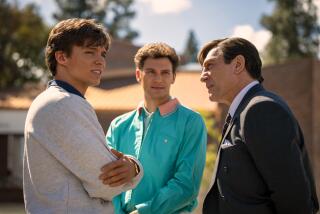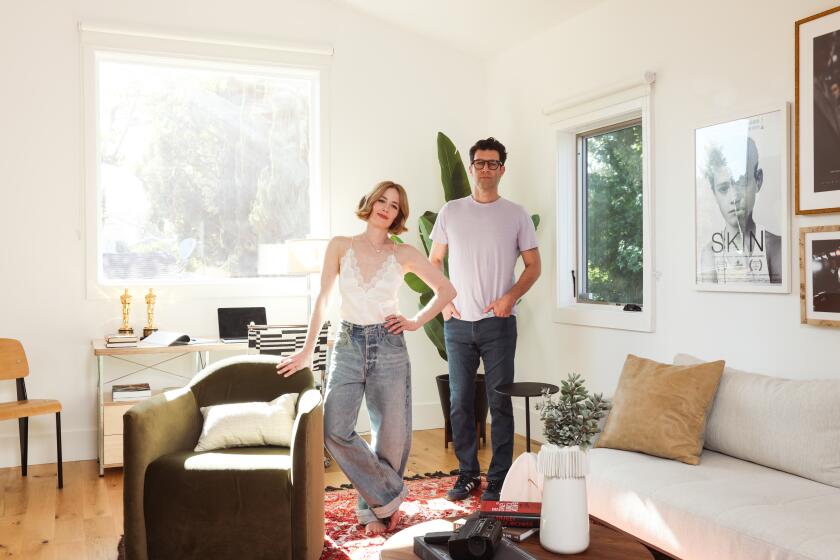The Movie Palaces: : Where Fantasies Replaced Real Life : Architecture: Few of the city’s opulent “film cathedrals” have survived the march of time. They evoke an era when fantasy didn’t stop at the screen.
It was the mid-1920s. The Golden Age of Movies had dawned in Los Angeles.
The city’s perpetually balmy climate, romantic landscapes and cheap real estate lured directors in jodhpurs, aspiring starlets and famous producers from the East to shoot countless comedies, musicals, swashbuckling epics and teeth-gnashing dramas.
As a result, competition for audiences grew fierce, forcing exhibitors to erect fantastic “film cathedrals” and “movie palaces” to rival Versailles. Architects were asked to recreate the Parthenon, Gothic churches, Louis XIV’s summer home, Far East temples--even the Paris Opera House. Designers filled their breath-taking interior spaces with Old Master paintings, priceless antiques, sculpture and babbling fountains.
“No king or emperors have ever wandered through more luxurious surroundings,” said theater decorator Harold Rambach in 1929.
Sadly, by the 1940s, the great movie palaces had succumbed to a terrible, lingering disease that proved fatal in many cases: faltering attendance due, in part, to kid brother television, who had come on the scene.
Thanks to aggressive lobbying by local historical preservation societies like the Los Angeles Conservancy and Hollywood Heritage, some of the grand movie palaces have been protected.
Here’s what remains:
Broadway between 3rd and 9th streets was the hub of Los Angeles’ theatrical activity in the late 1920s. Dominated by a dozen theaters, it boasted an audience capacity of more than 15,000.
The Palace (formerly known as the Orpheum) was built in 1911 at 6th and Broadway--the last two-a-day vaudeville house in America and later an exhibitor of silent films.
Designed in the French Renaissance style, the demure facade hides a white-marbled lobby and spacious auditorium featuring 85-foot, gold-leaf ceilings, two immense chandeliers, Scalamander silk wall paneling (only portions remain), and Broadway’s last Wurlitzer organ. First-run movies are still shown here.
The sumptuous Los Angeles Theater (615 S. Broadway) is the last movie palace built on Broadway. Designed in 1931, it was erected in 90 days and cost more than $1 million--a scandalous amount in Depression-stricken Los Angeles. The theater was built to imitate Versailles: its narrow lobby a miniature Galerie des Glaces , its auditorium fire curtain depicting 17th-Century courtesans in conversation in L’Arc du Triomphe.
The sweeping grand staircase is crowned by a four-tiered faux fountain, bubbling strings of crystal beads into a mosaic basin guarded by white marble sea serpents. At one time, the downstairs lobby contained a full-service nursery, replete with sandboxes and slide, a refreshment room and a projection area with a periscope for movie-viewing as patrons enjoyed a smoke. The ladies’ lounge features 16 individually hued marble toilet rooms and a Rococo-style makeup area, complete with small marble vanities.
Though the Los Angeles theater is in great need of a face lift, evidence of its former splendor is apparent. It continues to operate as a first-run movie theater.
Farther south is the United Artists Theater (933 S. Broadway), built in 1927. When Mary Pickford was vacationing in Spain, she fell in love with the country’s towering Gothic cathedrals. With her husband, Douglas Fairbanks, and Charlie Chaplin, Pickford commissioned the architectural firm of Walker & Eisen to create an immense United Artists flagship theater in the style of 12th-Century Spain.
Accentuating the theater’s weathered facade are pointed Gothic arches, stone apostolic figures and grotesqueries holding movie cameras. Inside are two high-ceilinged lobbies adorned with plaster frescoes and stained glass windows. The cavernous auditorium drips Gothic tracery; plaster stalactites cluster above the organ screen and proscenium opening. Wall murals by Anthony Heinsbergen depict Pickford and her UA comrades (Fairbanks, Chaplin, Pola Negri and Dolores del Rio) in their most famous roles.
The theater is now operated by televangelist Gene Scott as the University Cathedral. Scott has performed a meticulous restoration, returning the building to its original opulence.
By the late 1920s, palace architects grew weary of imitating Europe’s Beaux Arts style. Now they looked toward other worldly Xanadus and exotic vistas for their inspiration.
Around the corner from the United Artists is one such intriguing palace: the Mayan Theater (1040 Hill St.), constructed in 1926 to imitate the hulking ziggurats of Machu Picchu and Teotihuacan. It is the only remaining full pre-Columbian-style movie house in America.
Seven carved robed figures representing Huitzilpochtil, the Mayan God of War, stand sentry above the entrance. The theater’s exterior, once bare stone, is awash with brightly colored serpent heads, celestial symbols and hieroglyphics.
Like the interior of an ancient tomb, the lobby is small and dark. Giant serpent’s heads grin toothily from the stairwells. The auditorium sports enormous fragments of primitive walls and cast-concrete decorations. A gleaming multilayered sun symbol bursts from the ceiling.
The Mayan’s new owner, Sammy Chow, has converted the theater into a restaurant and nightclub, but has conscientiously preserved its design.
BEYOND DOWNTOWN
When the Broadway district became cinema-saturated, quick-thinking impresarios, led by Sid Grauman, fled to outlying environs. Hollywood, already America’s film capital, became the new center of movie palace operations.
The unearthing of King Tutankhamen’s tomb in 1922 fostered a wave of Egyptomania, which led Grauman to build the Egyptian Theater (6712 Hollywood Blvd.) that year. It remained the most popular Egyptian-style theater in America, and was widely copied.
Grauman spared no expense to evoke visions of the ancient Eastern past. Mammoth columns were scrawled with hieroglyphics; a uniformed Egyptian guard marched back and forth across the roof parapet, rifle in hand, during the theater’s opening. To obtain entry to the theater, moviegoers were forced to walk through a forested forecourt lined with mock tombstones and a bazaar of shops.
Although the tombstones, shops and uniformed sentry are gone and the Egyptian’s facade has been remodeled, the theater’s interior is intact. The movie house remains popular as a $1.50-a-show cinema, featuring second- and third-run films.
Grauman’s Chinese Theater (6925 Hollywood Blvd.) was Grauman’s last movie house and was considered the greatest of the Hollywood theaters.
Completed in 1927, it evoked Thomas Chippendale’s Chinoiserie--more Hollywood fantasy than Eastern design. Its exterior is a Buddhist temple; its interior is a Chinese palace. When a great gong sounded, heralding the start of one of Grauman’s prologues, movie goers were led through a giant elliptical forecourt of cocoa palms and rare tropical trees.
The theater is a world-famous tourist attraction, and the home of Grauman’s legendary “cement autograph” collection. It remains extremely popular as a first-run movie house.
The Wiltern Theater (3790 Wilshire Blvd.), completed in 1931, opened to a jubilee attended by thousands. But it was forced to discontinue operations after just one year. After resuming operation in the mid-1930s, this Zigzag Moderne masterpiece again was struck by faltering attendance. It shut its doors in 1979, falling into pitiful disrepair.
The Wiltern made headlines when it reopened after a highly publicized $4.8-million restoration job. The theater recently was heralded by architectural historian David Gebhard as “one of Los Angeles’ most outstanding public interiors.”
Inside its blue-green facade is a candy-colored lobby of Egyptian columns, tiled fountains, bas-reliefs, murals and frosty chandeliers. Its 2,300-seat auditorium features a goldandsilver sunburst exploding from a fiery orange ceiling.
Santa Catalina Island, the largest of Southern California’s Channel Islands, is home to what architect Charles Moore describes as “the finest Art Deco cinema left in the United States.”
The Avalon Theater (harbor-side at the end of Casino Way), is a glowing-pink expanse of floral friezes nestled below a silver-leafed ceiling dome atwinkle with stars. Wall murals depict the history of the island, featuring stylized antelopes, Indians and Spanish monks. Venus rises above the grillwork of the theater’s proscenium arch, as two Adonises surf on a wave’s crest aboard the theater’s fire curtain.
The Avalon was the first theater in the world to be acoustically engineered for sound. Cecil B. DeMille, L.B. Mayer and Sam Goldwyn frequently yachted to the island to preview their upcoming motion pictures in the theater’s auditorium.
Movies! Movies!
In June, the Los Angeles Conservancy presents “The Last Remaining Seats,” a series of old movies at the area’s film palaces.
* “The Cameraman” (1928), starring Buster Keaton, at the Orpheum Theater, 842 S. Broadway, Los Angeles; 7:30 p.m. June 3.
* “Movie Crazy” (1932), starring Harold Lloyd, at the Palace Theater, 630 S. Broadway, Los Angeles; 7:30 p.m. June 10.
* “Hollywood Cavalcade” (1939), starring Alice Faye and Don Ameche, at the Los Angeles Theater, 615 S. Broadway, Los Angeles; 7:30 p.m. June 17.
* “Sunset Boulevard” (1950), starring Gloria Swanson and William Holden, at the State Theater, 703 S. Broadway, Los Angeles; 7:30 p.m. June 24.
* “The Music Box” (1932), starring Laurel and Hardy, plus vintage cartoons, newsreels and historic clips of Los Angeles at the Rialto Theater, 1023 Fair Oaks Ave., South Pasadena; 11 a.m. June 30.
Admission: night show, $12; matinee, $6. For more information, contact the Los Angeles Conservancy, (213) 623-CITY.
More to Read
The biggest entertainment stories
Get our big stories about Hollywood, film, television, music, arts, culture and more right in your inbox as soon as they publish.
You may occasionally receive promotional content from the Los Angeles Times.










